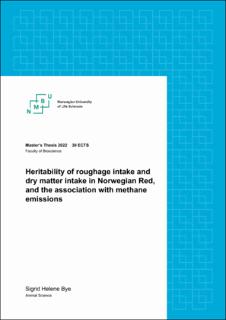| dc.description.abstract | The need to reduce the agricultural emissions and its environmental footprint has become more pressing in view of its continuing expansion to ensure food security and feed a growing world population. Farm profitability and environmental impacts can be reduced by selecting for lower methane emission and higher feed efficiency in dairy cattle. Projects on measuring methane emission and real feed intake in Norwegian Red (NR) cows are established to examine the relationship between methane emission and feed efficiency. In these projects, Geno has installed GreenFeed units to measure methane emission as well as equipment for monitoring individual roughage intake in commercial dairy herds.
Before implementing these novel traits in the breeding program of NR cows, it remains to be clarified how methane emission and feed efficiency traits are related to each other, which require direct and accurate large-scale measurements of the animals in the environment they are expected to perform in.
From one herd, data were registered daily on methane emission, dry matter-, roughage- and concentrate intake and daily milk yield from a Norwegian barn. Other information available included lactation number, days in milk and week of lactation. Methane data were available for a shorter period and the data foundation were too small to implement genetic analysis of methane. A dataset for methane and feed intake for 42 NR cows were used to analyse phenotypical correlations between methane and feed intake traits. The dataset for methane and feed intake traits contained 4,276 records. Dataset for feed intake traits for 63 NR cows were available from January 1st 2022 and used for genetic analysis of feed intake traits. The data contained 8,561 records. Daily average methane emission, dry matter intake from roughage and concentrate and roughage intake not corrected for dry matter intake is 413.2 grams per day, 19.2 kilograms and 36.3 kilograms, respectively.
Linear regression analysis showed that dry matter- and roughage intake has effects on methane emission, with every kilogram increase in dry matter- or roughage intake, gives an increase in methane emission of 2.8 and 0.6 grams per day, respectively. Phenotypic correlations between methane emission and feed intake traits were estimated to range from 0.15 to 0.25 and 0.25 between methane emission and milk yield. Heritability of dry matter- and roughage intake were estimated to be 0.42 and 0.35, respectively. Results should be interpreted with caution due to a limited dataset.
Further recommendations are analysis of genetic correlations between methane emission and feed intake. Estimates of genetic variation for the whole lactation period or life-span efficiency are needed in order to observe the relationship between feed intake and methane emission in every stage of life and lactation. Another recommendation is that research needs to find the best way to define feed efficiency, in order to draw effective conclusions. Additionally, observations for a larger number of animals are needed for estimation of the genetic relationship between feed intake and methane emission. | |
